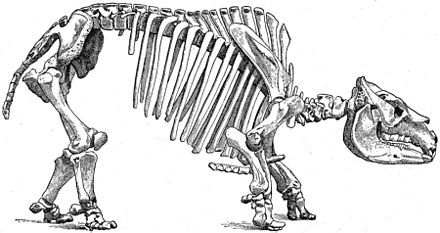toxodon:
Source: Wikimedia
Toxodon was a large herbivorous mammal that was similar in proportion to a rhinoceros, but also possessed other features that were similar to hippopotamuses and possibly even elephants. The post cranial skeleton has a very robust construction which suggests that in life Toxodon was a very heavy animal. The feet were plantigrade which means that Toxodon walked with the flat of its foot so that it could better support its body weight. The body was wide which suggests that Toxodon had an extensive digestive system for processing plant matter. The hind legs were much longer than the fore legs which meant that the main body sloped down towards the front. This also meant that the head was carried closer to the ground where Toxodon could feed upon low growing vegetation. The neural spines of the anterior dorsal vertebrae were enlarged, either providing anchor points for neck muscles that supported the heavy skull, or supported the formation of a fatty hump that served as storage for leaner times. [PrehistoricWildlife.com]
Mentioned in Archaeology Magazine:
ARGENTINA: Evidence continues to build that humans occupied the Americas well before the Clovis culture emerged around 13,000 years ago. At the site of Arroyo Seco 2, archaeologists have uncovered bits of stone tools and animal bones with telltale butchery marks dating to as long as 14,000 years ago. On the menu was a variety of extinct megafauna, including giant ground sloths, car-sized glyptodonts, and toxodons, rhino-like hooved animals with prominent incisors. —Samir S. Patel





